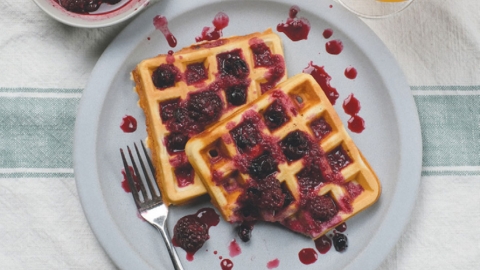Why isn’t Food on the Menu for New Jersey Breweries?
Late on a Saturday afternoon a few weeks back, I pulled into a brewery parking lot and noticed a taco truck parked near the taproom entrance. Tacos are a good decision any time of day, so before walking in I placed an order.
The owner of the truck, unaffiliated with the brewery but intimately aware of the beers on offer, suggested a pint of the Mexican lager to go along with my selection. I stepped inside, ordered the beer, and waited for my food to arrive.
When it did, there was an unexpected churro alongside the savory carne asada. A suggestion that the dessert should be paired with a short pour of the imperial stout was made. It was a thoughtful gesture and showed a synergy between food and beer that has long existed but does not always get the attention it deserves.
Especially here in New Jersey.
This interaction took place in Connecticut, a state we from the Garden State usually regard only as a land mass necessary to traverse to get to and from Boston. However, the Nutmeg State is more evolved than we are when it comes to allowing breweries—without kitchens—to have food trucks on the property.
In New Jersey there are different types of breweries: Taprooms offer only beer made on premises. Brewpubs have full liquor licenses and serve as restaurants with on-premises breweries. Other breweries are solely focused on production for distribution and are not open to the public.
A hundred years ago, our great state was home to large and respected breweries like Pabst, Rheingold, and Ballantine. Brewing was the fourth-largest industry in Newark and the seventh-largest in the state.
Prohibition and other factors decimated beer in the state and for the longest time the only beer production was coming out of the sprawling Anheuser-Busch factory along Routes 1 & 9 across from Newark Airport.
Plucky and determined entrepreneurs fought through draconian laws and launched the first wave of modern microbrewers here in the state in the late 1980s and early 1990s. A new crop of craft brewers opened in the early 2010s and there has been a steady stream of openings ever since.
THE SYNERGY BETWEEN FOOD AND BEER HAS LONG EXISTED BUT DOES NOT ALWAYS GET THE ATTENTION IT DESERVES.
This happened despite the laws that restricted how a brewery could operate, what type of food it could serve, who it could partner with, and even if they could turn on a television to watch a Devils game. Earlier this summer lawmakers passed legislation that would ease many of the restrictions, only to have the bill languish on Gov. Phil Murphy’s desk. The governor said he would rather focus on larger comprehensive legislative reform in the beverage alcohol space.
Brewpubs operate with a full, purchased liquor license and have an on-premises kitchen. Meanwhile, taproom breweries are not allowed to sell or serve food on site.
Murphy did instruct the NJ Division of Alcoholic Beverage Control to suspend the restraints against breweries until the end of the year while he works on the bigger plan.
• • •
The first of the modern American micro-breweries—starting with New Albion of Sonoma, California—were founded nearly 45 years ago. With them came flavor in a pint: roasted malts, citrusy hops, aromatic yeasts that went well beyond the Wonder Bread–like light lagers that had dominated the American beer-drinking landscape since the 1940s.
Of course, those light lagers still exist today and have gotten even lighter. But the thirst for flavorful ales and small-batch pilsners has never been greater. With more than 150 small breweries in our state, drinking local has become possible.
As the author of two beer-themed cookbooks and one, Dishing Up New Jersey, that celebrates the Garden State’s food traditions, I’m always looking for pairings that elevate what is on the plate and what is in the glass.
Sometimes it’s as simple as a porter paired with a cheeseburger. Other times it can be a dunkel paired with a breakfast burrito, a shandy with falafel, or an eisbock with beef cheeks and Stilton blue cheese.
Brewers are using locally grown ingredients and going beyond classic styles to incorporate culinary ingredients—spices, fruits, breakfast cereals, and coffee—into their recipes. Flavorful and fun as they are, proper bites are still preferred as a companion.
For the home cooks, inspiration is easy: Head to a local brewery. Get a flight of beers and think about the flavors of each one. Think about how a beer’s aroma and attributes could complement or contrast elements of a favorite dish. Then get a few cans or a crowler to go and get ready for a cozy night cooking (and sipping) at home.
The truly curious can get multiple beers of the same style from different breweries. This helps compare and contrast the flavors and methods produced by brewers. Still, having the chance to chow down on the spot where the beer is made should be commonplace, not feeling like a scandal.
Regardless of Jersey’s restrictive rules, this remains the best food state. The beer scene is growing, and together they shine brightly.
Beer tastes better with a meal. For now, to make the most of the dynamic pairings available in a brewery setting, we need to do what many of our state’s brewers are doing when thinking about the future of their businesses and locations: Look to Pennsylvania and New York.
Editor’s Note: In June, both the New Jersey State Senate and Assembly decisively passed legislation (S-3038 and A-4630) to bring positive reform to New Jersey’s brewery industry. As of press time, the legislation awaits the Governor’s action and consideration. Follow the New Jersey Brewers Association and New Jersey Brewers Guild for updates. njbeer.org; brewersguildnj.com







